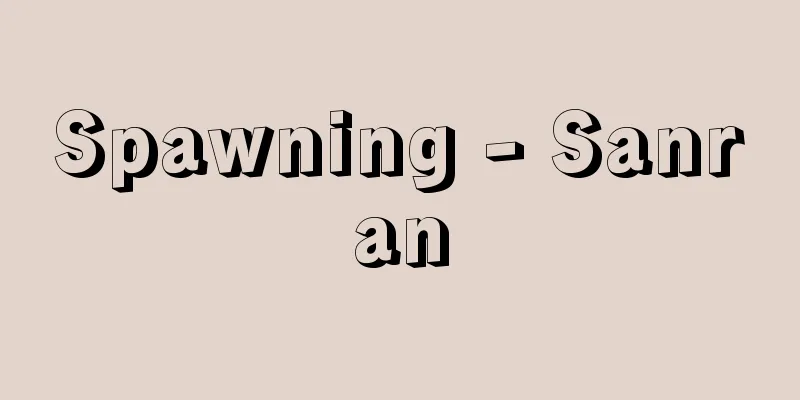Spawning - Sanran

|
When an animal lays eggs, fertilized eggs are expelled from the body in animals that are fertilized internally, and unfertilized eggs are expelled from the body in animals that are fertilized externally. In the case of fertilized eggs, the expulsion of early embryos that have already developed somewhat is also called spawning in a broad sense. When eggs are expelled into water, it is also called spawning. Eggs are released from the ovaries (ovulation) and often leave the body through the oviduct, but often a protective layer such as a jelly-like substance or a shell is added around the eggs during this process. For many animals, spawning is done in a fixed place, season, or time. For example, the Japanese sea urchin spawns on the day of the spring tide in early October, and salmon return to their natal river after several years of sailing to spawn. Spawning sites are also selected based on the eggs and larvae, and many animals build nests for spawning, and there are also cases where they lay eggs inside the bodies of other animals. The number of eggs laid at one time is called the spawning number, and the number can vary from one to tens of thousands. Spawning in the wild is governed by many factors, including temperature, day length, and other environmental conditions, as well as hormonal changes in the body. In some animals, it is possible to artificially induce egg laying by taking advantage of this fact. [Sadao Yasugi] Source: Shogakukan Encyclopedia Nipponica About Encyclopedia Nipponica Information | Legend |
|
動物が卵を産むことで、体内受精動物では受精卵、体外受精動物では未受精卵が体外に排出される。なお、受精卵の場合には、体内でやや発生の進んだ初期胚(はい)の排出も広義には産卵という。水中に卵を排出する場合はとくに放卵ともよぶ。卵は卵巣から放出(排卵)されて、多くは輸卵管を通って体外に出るが、しばしばその間にゼリー様物質や殻などの保護物が卵の周囲に付加される。多くの動物で産卵は場所や季節あるいは時間が決まっており、たとえばニッポンウミシダは10月上旬の大潮の日に産卵し、サケは数年の航海ののちに母川に帰って産卵する。産卵場所も、卵や幼生に都合のよい所が選択され、産卵のために営巣する動物も多く、また他の動物の体内に産卵する例もある。1回に産卵される卵の数を産卵数といい、その数は1個から数万に及ぶものまでさまざまである。自然状態での産卵は、温度・日長時間そのほか環境の種々の条件や、体内のホルモンの状態など多くの要因によって支配されている。いくつかの動物では、そのことを利用して人為的に産卵させることが可能になっている。 [八杉貞雄] 出典 小学館 日本大百科全書(ニッポニカ)日本大百科全書(ニッポニカ)について 情報 | 凡例 |
<<: Scattering - Sanran (English spelling)
Recommend
Kaneshige Toyo - Sadness Toyo
Ceramic artist. Born in Imbe Village, Wake County...
Spheniscus mendiculus (English spelling)
… [Hiroyuki Morioka]. … *Some of the terminology ...
Aturia (English spelling)
A genus of the cephalopod order Nautiloidea, a fos...
Bedroom - Shinshitsu
A room in a house for sleeping. In shinden-zukuri...
erfiöl (English spelling) erfiol
…The cost of the heir's feast is also a symbo...
Okuura
...Population: 2,815 (1995). The center is the To...
Koshi Night Talk - Kashiyawa
This is a collection of essays by Matsuura Kiyosh...
Iioka [town] - Iioka
A former town in Kaijo County, located in the nort...
August Schmarsow
1853‐1936 A German art historian and one of the pi...
Italian Marxism - Excessive Marxism
...The Communist Party based its cultural ideolog...
City Beautiful Movement
...After successfully completing the Chicago Worl...
Kaneodori - Kaneodori
...Dances performed to the violent beating of dru...
QA - QA
《 quality assurance 》Quality assurance. Source: Ab...
Land reclamation - tochizousei (English spelling)
Humans need land to carry out various activities. ...
Wyoming [State] - Wyoming
A state in the Rocky Mountains in the western Unit...









